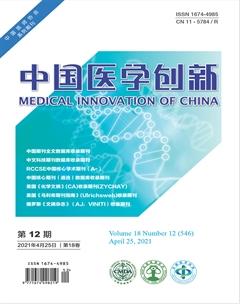血小板反应性与平均血小板体积对急性ST段抬高型心肌梗死相关梗死动脉自发再通的预测价值
李保银 万大国 刘淑珍 徐慧慧



【摘要】 目的:探討血小板反应性与平均血小板体积(MPV)对急性ST段抬高型心肌梗死(STEMI)相关梗死动脉(IRA)自发再通(SR)的预测价值。方法:回顾性分析2017年5月-2020年5月因急性STEMI在本院就诊的202例患者的临床资料。均行PCI治疗后根据TIMI血流分级结果将患者分为非SR组(n=152)和SR组(n=50)。比较两组患者的一般资料以及实验室结果,采用多因素二元logistic回归分析STEMI患者IRA自发再通的影响因素,采用受试者工作特征(ROC)曲线分析MPV、MARAA、MARADP预测急性STEMI患者IRA自发再通的价值,采用散点图绘制MPV与MARAA、MARADP关系并采用Pearson相关分析。结果:SR组的MPV、MARAA、MARADP均低于非SR组,差异均有统计学意义(P<0.05)。多因素二元logistic回归分析结果显示,MPV、MARAA、MARADP均是急性STEMI患者IRA自发再通的影响因素(P<0.05)。ROC曲线分析结果显示,MPV、MARAA、MARADP预测IRA自发再通的ROC曲线下面积分别为0.632[95%CI(0.543,0.721)]、0.628[95%CI(0.536,0.720)]、0.612[95%CI(0.518,0.707)],预测临界值分别为11.7 fL、56.5%、53.5%,预测临界值对应的灵敏度分别为0.72、0.84、0.79,特异度分别为0.48、0.38、0.36。Pearson相关性分析结果显示,MPV与MARAA、MARADP均呈正相关(r=0.553、0.454,P=0.004、0.017)。结论:MPV、MARAA、MARADP是急性STEMI患者IRA自发再通的预测因素,并且MPV与MARAA、MARADP呈正相关。
【关键词】 血小板反应性 平均血小板体积 心肌梗死 相关梗死动脉 自发再通 预测
Predictive Value of Platelet Reactivity and Mean Platelet Volume on Predicting Spontaneous Recanalization of Infarct-related Artery in Patients with Acute ST-segment Elevation Myocardial Infarction/LI Baoyin, WAN Daguo, LIU Shuzhen, XU Huihui. //Medical Innovation of China, 2021, 18(12): 00-006
[Abstract] Objective: To investigate the value of platelet reactivity and mean platelet volume (MPV) at admission on predicting spontaneous recanalization (SR) of infarct-related artery (IRA) in patients with acute ST-segment elevation myocardial infarction (STEMI). Method: Clinical data of 202 patients with acute STEMI admitted to our hospital from May 2017 to May 2020 were retrospectively analyzed. After PCI treatment, all patients were divided into non-SR group (n=152) and SR group (n=50) according to the results of TIMI blood flow grading. The general data and laboratory results of two groups were compared, and multivariate binary logistic regression was used to analyze the influencing factors of spontaneous IRA recanalization in STEMI patients. Receiver operating characteristic (ROC) curve was used to analyze the value of MPV, MARAA and MARADP in predicting spontaneous IRA recanalization in patients with acute STEMI. Scatter plot was used to plot the relationship between MPV, MARAA and MARADP, and Pearson correlation analysis was performed. Result: The MPV, MARAA and MARADP of SR group were lower than those of non-SR group, the differences were statistically significant (P<0.05). Multivariate binary logistic regression analysis showed that MPV, MARAA and MARADP were the influencing factors of spontaneous IRA recanalization in patients with acute STEMI (P<0.05). The ROC curve analysis results showed that the areas under the ROC curve for MPV, MARAA and MARADP to predict spontaneous recirculation of IRA were 0.632 [95%CI(0.543, 0.721)], 0.628 [95%CI(0.536, 0.720)] and 0.612 [95%CI(0.518, 0.707)], respectively. The predictive critical values were 11.7 fL, 56.5%, 53.5%, respectively. The sensitivity corresponding to the predictive critical values were 0.72, 0.84, 0.79, and the specificity were 0.48, 0.38, 0.36. Pearson correlation analysis showed that MPV was positively correlated with MARAA and MARADP (r=0.553, 0.454, P=0.004, 0.017).. Conclusion: MPV, MARAA and MARADP are predictors of spontaneous recanalization of IRA in patients with acute STEMI, and MPV is positively correlated with MARAA and MARADP.
[Key words] Platelet reactivity Mean platelet volume Myocardial infarction Infarct-related artery Spontaneous reperfusion Prediction
First-authors address: The Second Affiliated Hospital of Zhengzhou University, Zhengzhou 450000, China
doi:10.3969/j.issn.1674-4985.2021.12.001
急性ST段抬高型心肌梗死(ST-segment elevation myocardial infarction, STEMI)梗死相關动脉(infarct-related artery, IRA)自发再通是指急性STEMI患者在未接受溶栓等治疗的情况下行冠状动脉造影时发现,IRA前向血流达心肌梗死溶栓临床试验(thrombolysis in myocardial infarction, TIMI)血流分级2~3级,即定义为IRA的自发再通(spontaneous reperfusion, SR)[1]。研究发现,STEMI患者IRA自发再通的发生率占10%~30%,这部分患者的左心室功能及预后较好[2]。IRA自发再通的机制主要是血栓自溶,即冠状动脉不稳定斑块糜烂或破裂,释放血小板活化因子,血小板开始激活、聚集,同时凝血系统激活、纤溶系统随之激活,急性血小板血栓形成,当纤溶系统亢进时,血栓就会发生溶解,因此血小板在急性心肌梗死过程中起重要作用[3]。研究发现,血小板反应性不仅与急性冠脉综合征(ACS)患者的血栓形成、冠状动脉硬化严重程度有关,还能预测主要心血管不良事件发生[4-5]。而高平均血小板体积(MPV)与急性STEMI发生有关[6]。目前对血小板反应性、MPV与急性STEMI患者IRA自发再通的相关性研究报道较少。本研究旨在探讨血小板反应性、MPV对急性STEMI患者IRA自发再通的预测价值。现报道如下。
1 资料与方法
1.1 一般资料 回顾性分析2017年5月-2020年5月因急性STEMI在本院就诊的202例患者的临床资料。纳入标准:(1)符合中华医学会心血管病学分会2019年制定的《急性ST段抬高型心肌梗死诊断和治疗指南》中关于STEMI的诊断标准[7];(2)未经溶栓治疗;(3)发病12 h内接受急诊PCI。排除标准:(1)严重肝或肾功能不全;(2)严重心力衰竭;(3)合并严重感染;(4)合并恶性肿瘤、血液病。所有患者入院后立即行冠脉造影+冠状动脉介入治疗,由3名专业心血管介入医师根据TIMI血流分级评估冠脉血流情况。根据TIMI血流分级结果将患者分为非SR组(TIMI 0~1级,n=152)和SR组(TIMI 2~3级,n=50)。该研究已经伦理学委员会批准。
1.2 方法 收集患者的临床基本资料。入院后立即抽取静脉血送至实验室检查并且使用贝克曼库尔特AU480自动生化分析仪检测白细胞计数(WBC)、红细胞计数(RBC)、血小板计数(PLT)、MPV、血小板分布宽度(PDW)、血肌酐(Scr)、尿酸(UA)、总胆固醇(TC)、肌钙蛋白I(cTnI)、低密度脂蛋白胆固醇(LDL-C)、肌酸激酶同工酶
(CK-MB)、高密度脂蛋白胆固醇(HDL-C)。采用基因芯片行CYP2C19基因型检测氯吡格雷代谢水平,采用光电比浊法检测花生四烯酸(AA)诱导血小板最大聚集率(MARAA)及二磷酸腺苷(ADP)诱导血小板最大聚集率(MARADP)评价抗血小板反应性(未用药参考范围40%~80%,用药参考范围30%~50%)。
1.3 观察指标 分析MPV、MARAA、MARADP对STEMI患者相关梗死动脉自发再通预测价值及MPV分别与MARAA、MARADP的相关性。
1.4 统计学处理 采用SPSS 21.0软件对所得数据进行统计分析,计量资料用(x±s)表示,比较采用t检验;计数资料以率(%)表示,比较采用字2检验。采用多因素二元logistic回归分析探究自发再通的影响因素,采用受试者工作特征(ROC)曲线分析MPV、MARAA、MARADP预测急性STEMI患者IRA自发再通的价值,相关性分析采用Pearson分析。以P<0.05为差异有统计学意义。
2 结果
2.1 两组患者的一般资料比较 两组患者的年龄、性别等一般资料比较,差异均无统计学意义(P>0.05),见表1。
2.2 两组患者的实验室结果比较 两组的WBC、RBC、PLT、PDW、CK-MB、TC、cTnI、HDL-C、Crc、LDL-C、UA、氯吡格雷基因代谢比较,差异均无统计学意义(P>0.05);SR组的MPV、MARAA、MARADP均低于非SR组,差异均有统计学意义(P<0.05)。见表2。
2.3 影响IRA自发再通的多因素logistic分析 对MPV、MARAA、MARADP进行多因素二元logistic回归分析,以IRA是否发生自发再通赋值:否=0,是=1,结果显示,MPV、MARAA、MARADP均是急性STEMI患者IRA自发再通的影响因素(P<0.05),见表3。
2.4 MPV、MARAA、MARADP对IRA自发再通的预测价值 对非SR组与SR组的MPV、MARAA、MARADP数据进行ROC曲线分析,结果显示,MPV、MARAA、MARADP预测IRA自发再通的ROC曲线下面积分别为0.632[95%CI(0.543,0.721)]、0.628[95%CI(0.536,0.720)]、0.612[95%CI(0.518,0.707)],预测临界值分别为11.7 fL、56.5%、53.5%,预测临界值对应的灵敏度分别为0.72、0.84、0.79,特异度分别为0.48、0.38、0.36。见表4和图1。
2.5 MPV与MARAA、MARADP相关性分析结果 对SR组的MPV、MARAA、MARADP的数据进行散点图描记,并进行Pearson相关分析,MPV与MARAA、MARADP均呈正相關(r=0.553、0.454,P=0.004、0.017),见图2。
3 讨论
早期开通相关梗死动脉,及时恢复血流灌注可减少心肌梗死面积,可改善预后。血小板的黏附、活化和聚集在急性心肌梗死的病理生理过程中起着重要作用。研究表明,血小板高反应性与ACS患者的不良心血管事件预后有关,并与支架内血栓形成有关[8-9],同时也是预测STEMI患者5年死亡率及再次发生心肌梗死风险的有力指标[10]。Schanze等[11]认为这与血小板参与缺血-再灌注(IRI)有关,STEMI患者罪犯血管开通后,IRI损伤血管内皮细胞,通过多种途径活化血小板,如糖蛋白(GP)VI与Fc受体(FcR)的结合形成血小板胶原受体,血小板P2Y12受体介导持续的ADP依赖性血小板聚集反应,糖蛋白Ⅱb/Ⅲa受体诱导血小板聚集,
P-选择素活化血小板并介导细胞-细胞相互作用,另外G蛋白、血小板释放炎症介质、活性氧、血小板活化因子也可以激活血小板,以上途径均能增强血小板活性并加重IRI损伤,导致心功能恶化。同时Capranzano等[12]研究也表明血小板高反应性与STEMI患者PCI术前冠状动脉闭塞严重程度、高血栓负荷水平及PCI术后IRI损伤有关。Zhang等[13]认为这是因为在IRI损伤期间,心肌细胞及血小板的线粒体被激活,释放活性氧,引起氧化应激,形成微血栓,堵塞微血管,且增加氧耗,进一步释放活性氧,引起心肌损伤。本研究发现血小板低反应性与STEMI患者IRA自发再通有关,这是由于血小板活化的程度与先前缺血的持续时间和再灌注损伤的程度有关[14]。
MPV反映了骨髓中巨核细胞增生与血小板生成的情况,与血小板功能状态密切相关。新生的血小板体积较大,富含分泌颗粒,酶活性及亲和力较强,更容易发生黏附聚集[15]。研究发现,高MPV与STEMI患者的相关梗死动脉血栓负荷有关并可以预测短期预后[16],且MPV能够区分非血栓形成与血栓形成的急性心肌梗死[17]。可能的机制是在急性心肌梗死过程中,斑块破裂,局部破损斑块处的血小板被激活,释放更多血小板活化因子,诱导血小板加快聚集的速度和程度,血小板被大量消耗,反馈刺激巨核细胞加快新生血小板生成,导致骨髓中大体积血小板的释放,同时血小板被激活后由圆盘状转变为矛状,从而出现伪足,体积随之增大,MPV也增高。本研究发现MPV是预测STEMI患者IRA自发再通的因素,这与STEMI患者IRA自发再通的血栓负荷相对较小及血管自发开通有关。同时Wang等[18]研究发现入院时STEMI患者的MPV最高,随后下降,其推测MPV的下降与罪犯血管开通及入院前服用抗血小板药物有关。MPV是血小板反应性的量化指标。MPV同样也与血栓负荷有关。国外研究表明,STEMI患者PCI术前大血栓负荷组的MPV明显大于小血栓负荷组,且MPV增加是冠脉大血栓负荷的预测因子[19]。Jakl等[20]研究也证实MPV与血小板反应性有关,MPV越大,血小板反应性越高。本研究结果显示:MPV与血小板反应性呈正相关。本研究也存在不足:(1)本研究为回顾性研究,样本量少,需要大样本多中心研究证实;(2)急性STEMI患者入院前服用抗血小板药物,可能影响血小板反应性的试验结果。
综上所述,血小板反应性与MPV可以预测急性STEMI患者IRA自发再通,临床上可用于早期发现这些患者,为精准化治疗提供依据。
参考文献
[1] Haner J D,Siontis G C,Stoller M,et al.Spontaneous recanalization of a chronically occluded right coronary artery - When nature is more successful than technology[J].Int J Cardiol,2016,214:161-162.
[2] Li X,Li B,Gao J,et al.Influence of angiographic spontaneous coronary reperfusion on long-term prognosis in patients with ST-segment elevation myocardial infarction[J].Oncotarget,2017,8(45):79767-79774.
[3] Zhao Y P,Ji Y Y,Wang F Y, et al.Value of fibrinogen to albumin ratio on predicting spontaneous recanalization of infarct-related artery in patients with acute ST-segment elevation myocardial infarction[J].Zhonghua Xin Xue Guan Bing Za Zhi,2019,47(2):123-128.
[4] Yun K H,Ko J S,Lee J M,et al.Correlations between High Platelet Reactivity, Extent of Coronary Artery Disease, and Periprocedural Myonecrosis in Patients with Acute Coronary Syndrome[J].Chonnam Med J,2017,53(2):147-152.
[5] Lomakin N V,Buryachkovskaya L I,Sumarokov A B,et al.
Relation of Functional Activity of Platelets to Prognosis of Unfavorable Cardiovascular Events in Patients with Acute Coronary Syndrome. Results of a Registry Study[J].Kardiologiia,2019,59(10):5-13.
[6] Alvitigala B Y,Azra M,Kottahachchi D U,et al.A study of association between platelet volume indices and ST elevation myocardial infarction[J].Int J Cardiol Heart Vasc,2018,21:7-10.
[7]中華医学会心血管病学分会,中华心血管病杂志编辑委员会.急性ST段抬高型心肌梗死诊断和治疗指南(2019)[J].中华心血管病杂志,2019,47(10):766-783.
[8] Nishikawa M,Takeda Y,Isomura N,et al.Association between High Platelet Reactivity Following Dual Antiplatelet Therapy and Ischemic Events in Japanese Patients with Coronary Artery Disease Undergoing Stent Implantation[J].J Atheroscler Thromb,2020,27(1):13-24.
[9] Zhang J J,Gao X F,Ge Z,et al.High platelet reactivity affects the clinical outcomes of patients undergoing percutaneous coronary intervention[J].BMC Cardiovasc Disord,2016,16(1):240.
[10] Jakl M,Sevcik R,Fatorova I,et al.High on-treatment platelet reactivity: risk factors and 5-year outcomes in patients with acute myocardial infarction[J].Anatol J Cardiol,2017,17(2):113-118.
[11] Schanze N,Bode C,Duerschmied D.Platelet Contributions to Myocardial Ischemia/Reperfusion Injury[J].Front Immunol,2019,10:1260.
[12] Capranzano P,Capodanno D,Bucciarelli-Ducci C,et al.
Impact of residual platelet reactivity on reperfusion in patients with ST-segment elevation myocardial infarction undergoing primary percutaneous coronary intervention[J].Eur Heart J Acute Cardiovasc Care,2016,5(5):475-486.
[13] Zhang W,Chen C,Wang J,et al.Mitophagy in Cardiomyocytes and in Platelets: A Major Mechanism of Cardioprotection Against Ischemia/Reperfusion Injury[J].Physiology (Bethesda),2018,33(2):86-98.
[14] Zhou H,Li D,Zhu P,et al.Melatonin suppresses platelet activation and function against cardiac ischemia/reperfusion injury via PPARγ/FUNDC1/mitophagy pathways[J].J Pineal Res,2017,63(4):e12438.
[15] Karabacak M,Dogan A,Turkdogan A K,et al.Mean platelet volume is increased in patients with hypertensive crises[J].Platelets,2014,25(6):423-426.
[16] Suwailem S M,Elhammady W A,Elserafy A S,et al.
Association of mean platelet volume with angiographic thrombus burden and short-term outcome in patients with ST-segment elevation myocardial infarction undergoing primary percutaneous coronary intervention[J].QJM: An International Journal of Medicine,2020,113(Supplement-1).
[17] Amraotkar A R,Song D D,Otero D,et al.Platelet Count and Mean Platelet Volume at the Time of and After Acute Myocardial Infarction[J].Clin Appl Thromb Hemost,2017,23(8):1052-1059.
[18] Wang X Y,Yu H Y,Zhang Y Y,et al.Serial changes of mean platelet volume in relation to Killip Class in patients with acute myocardial infarction and primary percutaneous coronary intervention[J].Thromb Res,2015,135(4):652-658.
[19] Lai H M,Xu R,Yang Y N,et al.Association of mean platelet volume with angiographic thrombus burden and short-term mortality in patients with ST-segment elevation myocardial infarction undergoing primary percutaneous coronary intervention[J].Catheter Cardiovasc Interv,2015,85(S1):724-733.
[20] Jakl M,Sevcik R,Ceral J,et al.Mean platelet volume and platelet count: overlooked markers of high on-treatment platelet reactivity and worse outcome in patients with acute coronary syndrome[J].Anadolu Kardiyol Derg,2014,14(1):85-86.
(收稿日期:2021-03-02) (本文編辑:姬思雨)

